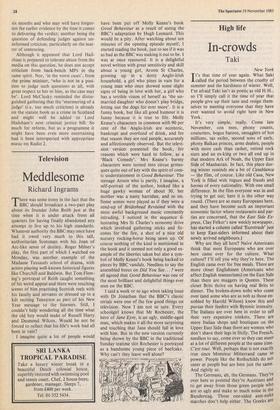Television
Meddlesome
Richard Ingrams
There was some irony in the fact that the BBC should broadcast a two-part play about its founder John Reith just at the time when it is under attack from all quarters for having finally abandoned any attempt to live up to his high standards. Whatever authority the BBC may once have had it owed very much to this tall, authoritarian Scotsman with his Joan of Arc-like sense of destiny. Roger Milner's play, the first part of which I watched on Monday, was another example of the Madame Tussauds school of drama, with actors playing well-known historical figures like Churchill and Baldwin. But Tom Flem- ing's portrayal of Reith caught something of his weird appeal and there were touching scenes of him practising Scottish reels with his family and servants or dressed up in a kilt reciting Tennyson as part of his New Year message to the listeners. Still, I couldn't help wondering all the time what the old boy would make of Russell Harty and Desmond Wilcox. Would he not be forced to reflect that his life's work had all been in vain?
1 imagine quite a lot of people would
have been put off Molly Keane's book Good Behaviour as a result of seeing the BBC's adaptation by Hugh Leonard. This would be a pity. After watching about ten minutes of the opening episode myself, I started reading the book, just to see if it was as bad as the BBC was making it out to be. I was at once reassured. It is a delightful novel written with great sensitivity and skill about a young girl, Aroon St Charles, growing up in a dotty Anglo-Irish household, a girl who pines in vain for a young man who once showed some slight signs of being in love with her, a girl who has a terrible vision of herself as 'the un- married daughter who doesn't play bridge, letting out the dogs for ever more'. It is a funny book, but like all good humour it is funny because it is true to life. Molly Keane's characters in common with 90 per cent of the Anglo-Irish are eccentric, bankrupt and overfond of drink, and for that reason they are real people, accurately and affectionately observed. But the televi- sion version presented the book, for reasons which were hard to follow, as a 'Black Comedy'. Mrs Keane's barmy characters were turned into circus grotes- ques quite out of key with the spirit of com- ic understatement in Good Behaviour. The teenage Aroon who is partly, I imagine, a self-portrait of the author, looked like a huge gawky woman of about 30, her mother was a nasty harridan, and so on. Some scenes were played as if they were a send-up of Brideshead Revisited with the most awful background music constantly intruding. I noticed in the sequence il- lustrating Mrs St Charles's economy drive which involved gathering sticks and fir- cones for the fire, a shot of a nice old nursery rocking-horse being sawn up. Of course nothing of the kind is mentioned in the book and it seemed not only a good ex- ample of the liberties taken but also a sym- bol of Molly Keane's book being hacked to pieces by BBC vandals. Needless to say the assembled bores on Did You See...? were all agreed that Good Behaviour was one of the most brilliant and delightful things ever seen on the BBC.
I said a week or so ago when taking issue with Dr Jonathan that the BBC's classic serials were one of the few good things on television. Now I am not so sure. Every schoolgirl knows that Mr Rochester, the hero of Jane Eyre, is an ugly, middle-aged man, which makes it all the more surprising and touching that Jane should fall in love with him. But in the new version currently being shown by the BBC in the traditional Sunday teatime slot Rochester is portrayed as a handsome young piece of beefcake. Why can't they leave well alone?


























































 Previous page
Previous page